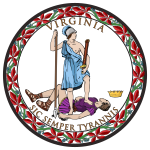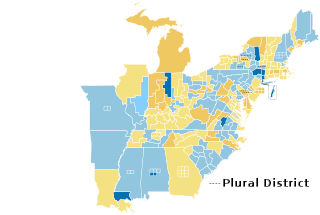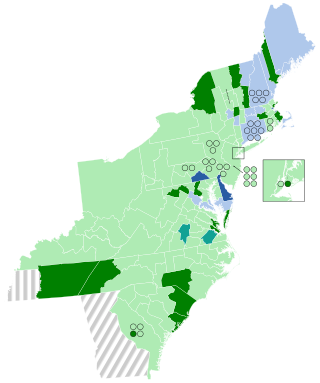| Elections in Virginia |
|---|
 |
| District | Incumbent | Party | First elected | Result | Candidates |
|---|---|---|---|---|---|
| Virginia 1 | John G. Jackson | Democratic-Republican | 1803 | Incumbent re-elected. | √ John G. Jackson (Democratic-Republican) 57.2% Thomas Wilson (Federalist) 42.8% |
| Virginia 2 | James Stephenson | Federalist | 1803 | Incumbent lost re-election. New member elected. Democratic-Republican gain. | √ John Morrow (Democratic-Republican) [lower-alpha 1] James Stephenson (Federalist) |
| Virginia 3 | John Smith | Democratic-Republican | 1801 | Incumbent re-elected. | √ John Smith (Democratic-Republican) [lower-alpha 1] |
| Virginia 4 | David Holmes | Democratic-Republican | 1797 | Incumbent re-elected. | √ David Holmes (Democratic-Republican) [lower-alpha 1] |
| Virginia 5 | Alexander Wilson | Democratic-Republican | 1804 (Special) | Incumbent re-elected. | √ Alexander Wilson (Democratic-Republican) 60.6% Robert Bailey (Quid) 39.4% |
| Virginia 6 | Abram Trigg | Democratic-Republican | 1797 | Incumbent re-elected. | √ Abram Trigg (Democratic-Republican) [lower-alpha 1] |
| Virginia 7 | Joseph Lewis Jr. | Federalist | 1803 | Incumbent re-elected. | √ Joseph Lewis Jr. (Federalist) 54.3% William Elzey (Democratic-Republican) 45.7% |
| Virginia 8 | Walter Jones | Democratic-Republican | 1803 | Incumbent re-elected. | √ Walter Jones (Democratic-Republican) 99.0% Henry Lee (Federalist) 1.0% |
| Virginia 9 | Philip R. Thompson | Democratic-Republican | 1793 | Incumbent re-elected. | √ Philip R. Thompson (Democratic-Republican) [lower-alpha 1] |
| Virginia 10 | John Dawson | Democratic-Republican | 1797 | Incumbent re-elected. | √ John Dawson (Democratic-Republican) 66.2% James Barbour (Quid) 33.8% |
| Virginia 11 | Anthony New | Democratic-Republican | 1793 | Incumbent retired. New member elected. Democratic-Republican hold. | √ James M. Garnett (Democratic-Republican) [lower-alpha 1] Carter Braxton John Roane (Democratic-Republican) John Smith Archibald Ritchie |
| Virginia 12 | Thomas Griffin | Federalist | 1803 | Incumbent lost re-election. New member elected. Democratic-Republican gain. | √ Burwell Bassett (Democratic-Republican) 65.1% Thomas Griffin (Federalist) 34.9% |
| Virginia 13 | Christopher H. Clark | Democratic-Republican | 1804 (Special) | Incumbent re-elected. | √ Christopher H. Clark (Democratic-Republican) [lower-alpha 1] |
| Virginia 14 | Matthew Clay | Democratic-Republican | 1797 | Incumbent re-elected. | √ Matthew Clay (Democratic-Republican) 88.9% William Lewis (Federalist) 11.1% |
| Virginia 15 | John Randolph | Democratic-Republican | 1799 | Incumbent re-elected. | √ John Randolph (Democratic-Republican) [lower-alpha 1] |
| Virginia 16 | John W. Eppes | Democratic-Republican | 1803 | Incumbent re-elected. | √ John W. Eppes (Democratic-Republican) [lower-alpha 1] |
| Virginia 17 | Thomas Claiborne | Democratic-Republican | 1793 1801 | Incumbent retired. New member elected. Democratic-Republican hold. | √ John Claiborne (Democratic-Republican) 72.7% Mark Alexander (Democratic-Republican) 27.3% |
| Virginia 18 | Peterson Goodwyn | Democratic-Republican | 1803 | Incumbent re-elected. | √ Peterson Goodwyn (Democratic-Republican) [lower-alpha 1] |
| Virginia 19 | Edwin Gray | Democratic-Republican | 1799 | Incumbent re-elected. | √ Edwin Gray (Democratic-Republican) [lower-alpha 1] |
| Virginia 20 | Thomas Newton Jr. | Democratic-Republican | 1799 | Incumbent re-elected. | √ Thomas Newton Jr. (Democratic-Republican) Unopposed |
| Virginia 21 | Thomas M. Randolph | Democratic-Republican | 1803 | Incumbent re-elected. | √ Thomas M. Randolph (Democratic-Republican) 63.7% Walter Leake (Quid) 36.3% |
| Virginia 22 | John Clopton | Democratic-Republican | 1801 | Incumbent re-elected. | √ John Clopton (Democratic-Republican) [lower-alpha 1] |







